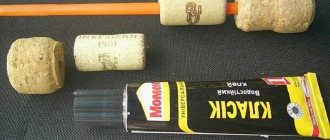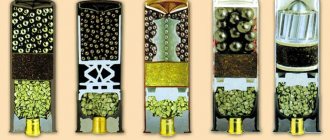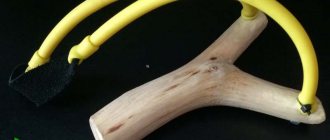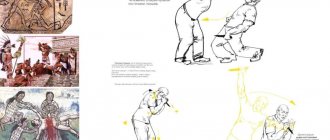- May 5, 2019
- Weapons and ammunition
- Natali Michaelis
The ideal option for hunting for almost any prey is a smooth-bore weapon equipped with shot cartridges. However, the cost of modern ammunition leaves much to be desired, so many hunters prefer to equip their own cartridges. 16 gauge is considered almost universal and is suitable for both beginners and professionals, so in our article we will look at an example of equipping just such ammunition.
Why is it worth loading your own cartridges?
For 2020, the minimum cost of one shot cartridge in hunting stores is 25 rubles. Moreover, such ammunition is far from the highest quality. As a rule, they are made using cheap gunpowder, harmful lead and cartridges made of second-grade plastic, which often burns out during the ignition of the gunpowder. Capsules often misfire, and reusing such ammunition is life-threatening.
You can, of course, purchase cartridges from branded manufacturers, but such pleasure will cost from 50 to 100 rubles per cartridge. It is precisely because of the high cost that many hunters are wondering how to load 16-gauge cartridges on their own. After all, the financial side of the issue worries most people, since few people have extra money.
What you need to know when loading ammunition
Every shooter should have an understanding of how cartridges are loaded with their own hands. When starting this procedure, it is worth remembering a number of misconceptions regarding this area. Thus, beginners are often convinced that the more gunpowder there is, the more powerful the shooting will be. However, it is not. The practice of the most experienced hunters and laboratory studies have proven that when adding gunpowder, it is imperative to observe the measure. It is important to consider that cans with this component often indicate not the average required weights, but the maximum allowable ones.
If a hunter in warm weather loads a cartridge with a maximum weight of gunpowder of 2.5 g and shot of 35 g, then the gun will have extremely strong recoil, the accuracy of fire will decrease significantly, and the shot will be deformed. As a result, it will not be balls that will fly towards the target, but deformed lumps of lead. They will lose speed extremely quickly. When shooting at a distance of 35-40 meters, wounded animals will be the most common occurrence. However, the fact that the shot will be deformed will reduce not only the rate of fire, but also the accuracy. For this reason, all hunters have long been convinced that it is best when there is less deformed shot.
Pros of self-loading ammunition
In addition to the financial component, which is a fundamental factor when equipping 16-caliber cartridges at home, it is also possible to highlight a number of other advantages of “roll-your-own cigarettes”, which would be unfair to ignore:
- confidence in quality (using good materials);
- the ability to adjust the amount of gunpowder and shot in the cartridge;
- longer shelf life and operation.
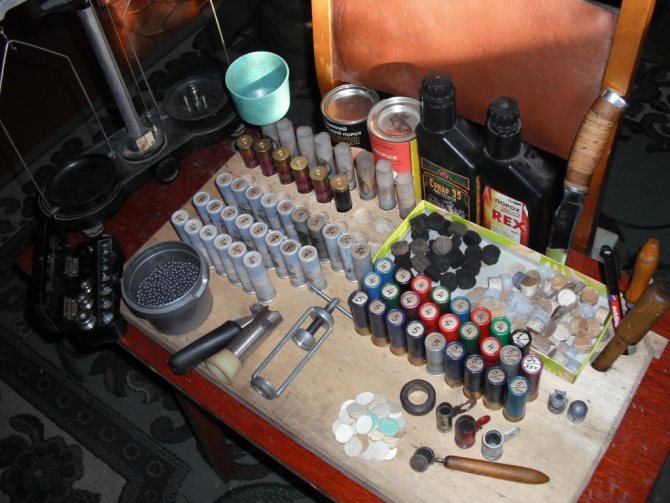
Even if you purchase expensive gunpowder and good steel shot, the cost of all components for one cartridge will be significantly lower than if you purchased it ready-made. However, it is also worth paying attention to possible disadvantages.
Device for capsules
Many people refuse to use devices for removing and installing primers, considering it a waste of money. Instead, they knock out the spent primer with a homemade device. Often made of wood with a needle inserted, after which a new one is installed, driving it in with a hammer with precision. Of course, this allows you to reduce costs when purchasing equipment.
But still, a special device greatly simplifies the work. It becomes easier to remove the primer, and the risk of damaging the bottom of the cartridge case (if a centrifugal primer is used) is reduced. Moreover, it makes it easier to install the capsule - it only takes a second or two. There is no risk of the capsule exploding due to a careless blow with a hammer. So, if possible, it is still worth purchasing this useful device. Many hunters who independently load 16-gauge cartridges leave mostly positive reviews about it.
Disadvantages of rolling papers
Perhaps the biggest disadvantage of making homemade ammo is that you will need to buy some equipment. A new 16-gauge reloading kit can be quite expensive, so it's best to buy it second-hand to save some money.
We should also not forget that equipping cartridges is a rather long and painstaking process that will require a huge amount of time from the hunter. Not everyone has it, but for pensioners this disadvantage is not significant.
It should be noted that many hunters actively buy hand-rolled cigarettes, so your time and money can pay off quite quickly. All you need to create high-quality cartridges is more practical skills and a desire to develop in this area.
Which machine is better to use?
For loading plastic cartridges, this device is considered simply vital, since it allows not only rolling, but also pressing in gunpowder and shot, so that the ammunition turns out to be of the highest quality. You should choose a machine for loading 16-gauge cartridges based on your individual preferences: from mounting the device (to a table or without mounting at all) to the form of rolling (round and star).
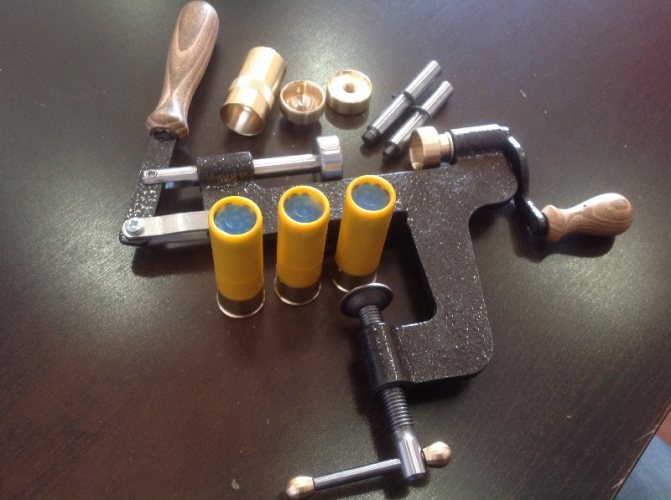
In online stores and on various websites you can find a large assortment of similar devices that differ in functionality and cost. In order not to get confused in all these models, try to find a Soviet machine for rolling cartridges, since it is relatively inexpensive and has a fairly good service life. In addition, a novice gunsmith will not need most of the functions that are found in expensive devices.
Selecting scales
In this case, everything is much simpler than in the previous one. Preference should be given to electronic scales, also called pharmacy scales. Since even one extra gram of gunpowder can lead to dire consequences, it is recommended to choose a device that displays milligrams - in this case the error will be minimal. Also, you will need to purchase some kind of metal container for the scales so that it is convenient to pour gunpowder or shot into it and put it on the scales, having first reset the tare weight value on them.
Shells or wad containers?
An age-old question that worries both amateurs and professional hunters. The so-called container ammunition has one design feature - the presence of a special wad container, which allows you to maintain the initial shape of shot or buckshot for a longer time. Because of this, container ammunition is most often used for shooting from a distance of 50 meters, since they have a good accuracy rate.
If you cannot decide what kind of ammunition to make - modern or classic, then we recommend that you first think about the purpose for which these cartridges will be used. For example, if you want to go duck hunting, then regular cartridge ammunition will be sufficient, which allows you to shoot down a bird on the fly. But for hunting wild boar or bear, container cartridges perform best.
Loading a grape cartridge for high-accuracy shooting
The principle of equipping a buckshot cartridge for mass shooting is exactly the same as described above, but it requires only 9 8mm buckshot shells, the buckshot shells are stacked in threes, also in the rows described above. Below are photos of shooting such cartridges into trees from a distance of 30-35 meters, as you can see there is good accuracy for a buckshot cartridge; with good aiming, all the buckshots will hit big game.
Photo. Holes of a bunch of grapeshot cartridges from payday.
Someone will have a question why such methods of equipment give such a fight, I can’t say for sure, all this equipment was tried in different versions. But I can assume that the sawdust provides a kind of container for buckshot, the buckshot does not touch each other, thereby deforming less, three buckshots in a row fit well in the barrel, four are slightly deformed, which causes them to deviate from the straight trajectory of the shot.
Photo. Holes of a bunch of buckshot cartridges from a choke.
The shooting was carried out at the Ash tree, it is very strong; it is impossible to drive a nail into it, but all the buckshots went very deep into the tree, which indicates good sharpness of the battle, which means they will hit the animal very well.
What I like about equipping these buckshot cartridges is that they give a very constant fight, without throwing out surprises when all the buckshot can scatter in different directions and not one of them will hit the target. These cartridges, with their accuracy, make it possible to hit small game, such as a hare, not to mention a larger animal.
This method of loading a buckshot cartridge is suitable for buckshot of any diameter; if you lay buckshot of a smaller diameter, taking into account its consistency in the barrel, thanks to the sawdust, you can create layers of buckshot that do not touch each other, you can achieve different accuracy. You can also use a container; the container is inserted onto the gunpowder, and then the buckshot is placed in the described manner in layers and sprinkled with sawdust. As you can see, to select the right cartridge and the required accuracy, you can experiment as you like, but do not go beyond the permissible weights of gunpowder and buckshot. I hope my experience will be useful to novice hunters, since by loading cartridges taking into account the characteristics of your gun, you can achieve good shot performance in both sharpness and accuracy, but any loaded cartridge must be shot at the target to be sure that you have achieved what you were aiming for.
What’s interesting is that the guns are all the same in concept, but each has its own fire, the same cartridge in different guns will give its own accuracy, but by empirically selecting the cartridge’s equipment, you can improve the accuracy of even an unimportant gun.
Therefore, a factory cartridge will always give average performance, and a cartridge selected experimentally for a specific gun will give excellent accuracy and sharpness of the fight, without tearing the gun and not giving strong recoil, knocking off the hunter’s shoulder.
Plastic or brass
It's no secret that 16-gauge hunting cartridges can use a plastic or brass case. The use of the latter option when hunting may be justified if you prefer to hunt with a classic single-barreled gun. In addition, you can later replace the old primer and reuse the cartridge case. This is where brass cartridges have a huge advantage over plastic products.

However, a significant disadvantage of brass cartridges is that spent cartridges will be quite difficult to find in grass or water, so in this case it is better to give preference to plastic. Of course, the methods of equipping these two types of cartridges are significantly different from each other, so we will consider each of them separately.
The order of loading cartridges
Now we’ll briefly tell you how to load 16-gauge cartridges.
Are you using an old sleeve? Knock out the primer and clean the anvil (if there is one, the Zhevelo primer cartridges do not have one). If new, then feel free to skip this step.
Insert a new capsule - preferably using special equipment. Now pour in the gunpowder - using a measuring stick or carefully measuring each grain on the scale - it's your choice. Next is the wad – thick, made of felt or pressed sawdust. But if you use a container, you can do without it - plastic solves this problem.
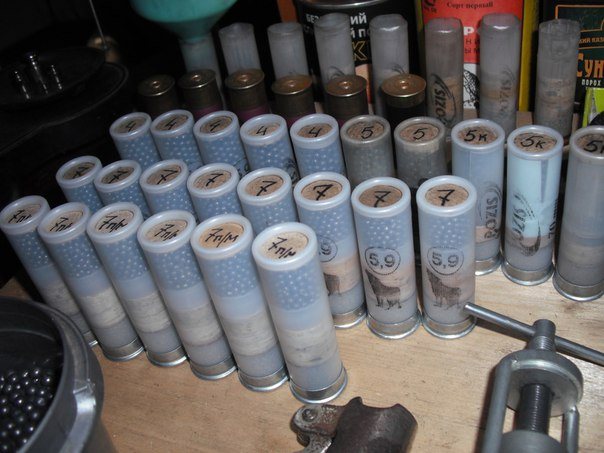
Then the shot is filled in or the bullet is installed. Now it all depends on the type of sleeve: either a finishing paper wad (when using brass ones), or twisting on a machine (when working with plastic ones). When working with brass, all that remains is to fill the sleeve with wax or paraffin and everything is ready - you can go hunting!
Instructions for loading plastic cartridges
After you manage to get all the necessary components, we begin to load 16-gauge cartridges. This must be done strictly according to the instructions given below, observing the proportions of gunpowder and shot, which can be found in the next section.
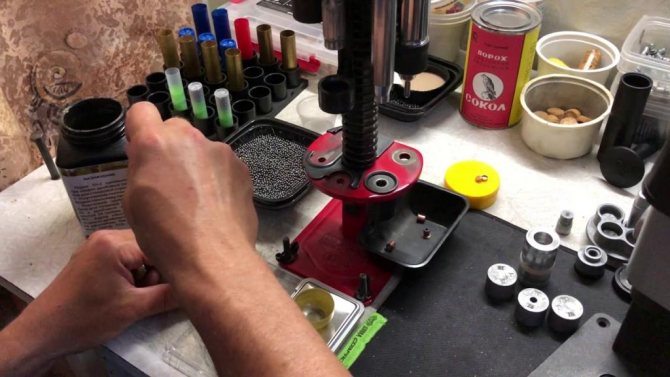
- We check all cartridges for damage, especially on the primers.
- We measure the required amount of gunpowder on an electronic scale.
- We pour gunpowder inside and use a special press.
- We install the gasket on the powder.
- We measure the fraction on the scales.
- Pour the fraction inside.
- Let's roll it up.
After this, all that remains is to mark the cartridge so that you do not forget which shot number you used. Remember that even the slightest error in calculations can be catastrophic, so be extremely careful.
How to properly load a 16 gauge cartridge
Brass sleeve, CB primer, “Falcon” gunpowder 1.75g-summer, 1.85g-winter (on a tin 2.3 for 12kb), powder cardboard wad 3mm, VP ungreased, fiberboard, cardboard spacer 1mm, shot 28g, cardboard gasket for 1mm shot, filling - rosin + paraffin.
All wads and spacers are 12kb. The fight is sharp and heaped, I am satisfied. Preparation of rosin-paraffin filling: Yes, I forgot, I carry out this whole procedure in the open air, with the participation of a fryer and a blowtorch, however it stinks. When equipping, I melt the finished composition in a steam bath, but it doesn’t stink 1.
Sleeve folder or plastic. 3. Sokol gunpowder - under a P/E wad-obturator (wad-container) t above +10 - 1.8 g. If with an asterisk, I reduce the amount of gunpowder by 0.1 g. 5b.
The ratio of shot and gunpowder in cartridges
It is worth noting that the weight of gunpowder and shot can vary significantly for different brands of flammable substance, as well as different numbers of ballistic projectiles. Therefore, as an example, we will consider equipping cartridges with falcon gunpowder and number five shot.
| Amount of fraction in grams | Amount of gunpowder in grams | The ratio of shot and gunpowder |
| 26 | 1,7 | 15,3 |
| 27 | 1,8 | 15,0 |
| 28 | 1,8 | 15,5 |
| 29 | 1,9 | 15,3 |
| 30 | 1,9 | 15,8 |
The powder weight can be increased by a maximum of 10% from the values presented in the table. Most often, this is done in order to increase the initial speed of a ballistic projectile and maintain accuracy at long distances. You can experiment a little with the weights, maintaining optimal proportions and shooting at targets from different distances. Thus, you will see how the accuracy of shooting changes depending on what number of shot and the amount of gunpowder used in the ammunition.
It is not at all difficult to notice a certain pattern in the “cartridge-game” relationship: the smaller the shot, the less responsible the shot. A missed or wounded crake or snipe is, of course, annoying, but a missed goose or fox is even more so. Although fans of hunting swamp and field game with a pointing dog may not agree with me. But even without taking into account the objective cost of the trophy, the very nature of preparation for hunting big game increases the responsibility for the shot. Buckshot is precisely intended for hunting large game, such as wild boar, roe deer, wolf, lynx, therefore special requirements are placed on the quality of the action of buckshot cartridges. Buckshot is considered to be a placer projectile with a diameter of an individual pellet (buckshot) from 5.5 to 9.0 mm, each of which has quite a decent mass, approximately from 1.0 to 4.5 g. And such a significant mass contributes to maintaining speed for a relatively long time each buckshot, and therefore the destructive power. And it is advisable to use such qualities of buckshot as fully as possible, i.e., strive to ensure a good scattering of buckshot at the greatest possible shooting distance. It should not be argued that buckshot should be shot at ultra-long distances (70 meters or more), since the limited number of damaging elements in the projectile does not allow placing the 3-4 buckshots necessary for reliable destruction in the killing zone of the animal. It must be remembered that, although shooting is carried out at relatively large animals, you need to target the animal exactly “in place” and in this case a grapeshot shot is akin to a bullet shot. And special attention should be paid to such characteristics of shot scree as accuracy. We have already spoken above about the positive effect of “coordinated” shot on the accuracy of combat, but for buckshot, “consistency” is even more important. This is explained very simply. The forces that arise during the restructuring of a buckshot projectile in a choke constriction are quite large and noticeably deform almost every buckshot shell both against the barrel wall and at the same time against each other. And this leads to a noticeable deviation of the deformed buckshot by the oncoming air flow from the normal trajectory, and to a rapid loss of speed, i.e., the accuracy and range of destruction actually decreases.
Buckshot is matched according to the choke constriction, the diameter of which may be 1.0-1.25 mm less than the diameter of the bore to the choke. As you know, the inner diameter of the cartridge case is close in size to the size of the bore, and buckshot matched to the choke in the cartridge case will dangle. This means that when loading cartridges, especially for guns with strong chokes, the buckshot in the case must be separated from the walls of the case either by some kind of gasket of appropriate thickness, or the column of buckshot must be allowed to reach the choke without losing its shape, due to the bulk seal.
Of course, for a barrel with a cylindrical drill, the buckshot must be matched to the bore.
The technique for selecting a matched fraction has already been given above; it is not complicated, but there is no need to carry out the entire operation yourself. For each size of the choke (or bore for cylindrical drilling), the optimal size of one buckshot was determined when laid in a row of 3, 4, 5, 7 pieces (Table 3).
Table 3
Selection of matched buckshot Diameter of the muzzle constriction, mm (First column) Diameter of matched buckshot, mm with the number of buckshot in a row, pcs. ======3==4==5==7 12.2 5.70 3.05 4.43 4.06 12.4 5.81 5.15 4.50 4.13 12.6 5.90 5.22 4.57 4, 20 12.8 6.00 5.31 4.65 4.27 1.3.0 6.09 5.38 4.72 4.33 13.2 6.17 5.49 4.79 4.40 13.4 6.27 5.56 4.86 4.47 13.6 6.38 5.64 4.93 4.53 13.8 6.45 5.72 5.00 4.60 14.0 6.55 5.80 5.08 4.67 14.2 6.62 5.88 5 ,14 4.73 14.4 6.74 5.97 5.23 4.80 14.6 6.83 6.05 5.29 4.87 14.8 6.91 6.13 5.37 4.93 15.0 7.01 6, 22 5.42 5.00 15.2 7.11 6.30 5.51 5.07 15.4 7.20 6.38 5.58 5.13 15.6 7.30 6.49 3.66 3.20 15.8 7.38 6.56 5.74 5.27 16.0 7.48 6.62 5.80 5.33 16.2 7.57 6.71 5.87 5.40 16.4 7.68 6.80 5.94 5.46 16.6 7.76 6, 89 6.02 5.53 16.8 7.87 6.98 6.10 5.59 17.0 7.97 7.03 6.16 5.66 17.2 8.04 7.11 6.24 5.73 17.4 8.14 7.21 6.30 5.80 17.6 8.22 7.30 6.38 5.86 17.8 8.32 7.39 6.46 5.93 18.0 8.41 7.46 6.52 6.00 18, 2 8.50 7.52 6.59 6.07 18.4 8.60 7.62 6.67 6.13 18.6 8.70 7.70 6.75 6.20
However, it should be noted that buckshot produced by our industry or imported from abroad may not always coincide with the dimensions from the above table. For example, for a choke with a diameter of 17.8 mm, buckshot with a diameter of 6.46 mm fits five in a row, and buckshot with a diameter of 6.5 and 6.3 mm is available for sale. The first, although not much, is large, this is bad, it is always better to use buckshot of a smaller diameter, choosing the resulting gap using various techniques. There are several ways to do this. Buckshot cartridges loaded with these methods were shot at TsNIITOCHMASH in batches of five, and the improvement in accuracy was determined relative to the performance of a cartridge loaded in the usual way with unmatched buckshot without the use of any concentrators. The weight of Sokol gunpowder for all cartridges was 2.2 g for the 12 gauge, 1.8 for the 16 gauge and 1.4 for the 20 gauge. Weight of a buckshot projectile: for the 12th caliber 33-39 g, for the 16th - 28-32 g, for the 20th - 25-31 g. Shooting was carried out at a distance of 35 m at a target with a diameter of 75 cm. The buckshot with which they were equipped cartridges were of high quality, made by stamping.
Now we will talk about methods for sampling the gap that is formed when using buckshot that matches the muzzle and the barrel wall, as well as when using buckshot with a diameter less than optimal.
Method one. We have already talked about it, this is sprinkling the buckshot shell with potato flour (talc is also used for this purpose), not forgetting to reduce the weight of the buckshot in the shell by the weight of starch. Accuracy increases to 10%.
Method two. Laying buckshot in a cartridge case in rows strictly one above the other. Usually, each upper row finds its own place in the sleeve, shifting by half the diameter of the buckshot, i.e., located in the gaps of the buckshot shells of the lower row. The proposed method is to arrange the buckshots in the sleeve in a column, one above the other. This can be achieved using polyethylene and paper inserts, matches, plastic containers, etc. Now on sale you can find buckshot of different sizes, stacked in a column in the nests of the container. Information about the mass of this projectile is available on the packaging. Combat accuracy improves by about 20%.
Method three. It is used only if buckshot is used, the full row of which in the case has a central buckshot, and the buckshot is slightly larger in size than agreed upon. The buckshot is placed in a circle along the wall of the cartridge case, and the central column is not placed. Accordingly, the mass of the projectile decreases, and the initial speed increases. Technically, this is done as follows. A stick with a diameter equal to the buckshot is placed vertically in the center of the cartridge case on the wad, and buckshot is placed in rows around it. Then the stick is broken off or cut off at the level of the top row and, without inserting a shot wad, the sleeve is twisted with a regular twist, after which the rest of the stick can be removed. Accuracy can increase up to 25%.
Method four. The buckshot is placed in a cup or ring made of plastic film or photographic film. If a cup is intended, then a strip of film is cut to a height equal to the height of the column of buckshot plus half the diameter of the cartridge case. Its length depends on the number of revolutions around the column of buckshot that need to be made in order to select the gap between the wall of the sleeve and the column of matched buckshot. The bottom line of the strip is cut to the extent of half the diameter of the cartridge case, then the strip is rolled into a ring and placed on the powder wads, bending the petals formed from the cuts so that they form the bottom. The buckshot is placed in a cup (or in a ring, if without a bottom) in regular rows. If a row does not work out due to the larger diameter of the buckshots, then one is removed from it, accordingly selecting the resulting gap with a large number of revolutions of the film. With this method of equipment, accuracy increases to 24%.
Method five. It is recommended only for shotguns with cylindrical bores. This is the “ring of Eleus” already familiar to readers. A buckshot cartridge is loaded in the same way as a shotgun cartridge (see description in the previous publication). Only the first row of buckshot, on which the “ring” is placed, should preferably be made up of buckshot shells of larger diameter, consistent with the bore (cylinder), while the rows of buckshot in the “ring” will have a smaller diameter. The best results are obtained from cartridges loaded with coarse or medium black powder. Against conventional equipment, accuracy can increase to 70%. With smokeless powder the results are noticeably worse.
Based on the results of the shooting, we can draw the following conclusion that the best and most stable results are obtained by a cartridge equipped as follows: matched buckshot, stacked, sprinkled with starch. In relation to specific hunts for 12-gauge shotguns with strong chokes, the best equipment for a wolf can be considered buckshot with a diameter of 5.8 mm (28 pcs.), projectile weight 33 g, with a ring or cup (method four) if it is necessary to coordinate the buckshot with the choke . For shooting at a wild boar, the best one should be considered a 12-gauge cartridge consisting of nine buckshots with a diameter of 8-8.5 mm (three in a row), matched with a choke. When assessing the quality of a shot, you should focus on the following results. At a distance of 35 m, the accuracy on a target with a diameter of 75 cm must be at least 75%, i.e., at least 75% of the buckshots in the cartridge must be in the target and at least 50% in a “small” circle with a diameter of 37.5 cm. Taken here: www.piterhunt.ru/library/books/patrony_povyshennoi_moshchnosti_snaryazhenie_pulyami_i_kartechyu/snaryazhenie_patronov
Equipment brass shells
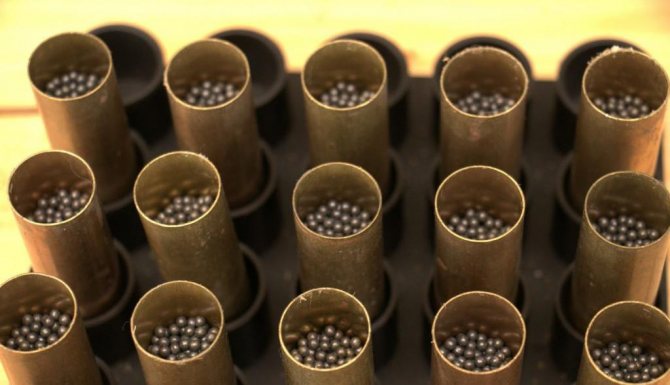
The only difference between equipping brass ammo and plastic ammo is the last point. There is no need to roll brass cartridges, and most hunters prefer to simply install several quick-burning gaskets, for example, made of cardboard, on top of the cartridge, and then seal them with tape. By the way, a similar manipulation can be carried out with plastic cartridges in order to increase the accuracy of combat at long distances.
2.3.4. Loading cartridges with large shot and buckshot
2.3.4. Loading cartridges with large shot and buckshot
Wolf, roe deer, and saiga are shot with grapeshot;
Buckshot is also used for hunting lynx, musk deer, and small boar at a distance of 35–40 m, rarely further. It should be noted that grapeshot shooting in hunting aims to more reliably hit a relatively large animal due to a larger number of damaging elements than is available when shooting with a single bullet.
For shooting wolves from 12-gauge shotguns with chokes, a cartridge loaded with small (5.8 mm in diameter) matched buckshot has long been used; the projectile consists of 28 buckshots (4 rows of 7 buckshots each) with a total weight of 33 g. The projectile is placed in a cup (or ring) made of paper (or plastic film). For wild boar hunting, larger buckshot is used, with a diameter of 8–8.5 mm; For a 12-gauge shotgun shell, there are 9 buckshots (3 rows of 3 buckshots each).
Hunting stores receive not only buckshot, but also factory cartridges loaded with buckshot. Shooting ready-made cartridges with large buckshot (3 rows of 3 buckshot in each row), laid out in the most primitive way (the upper buckshots lie in the spaces between the lower ones), gave good results: at 35 m the entire projectile was placed in a circle of 59–77 cm, the pressure was normal. However, keep in mind that factory cartridges are fired from a 0.5mm ballistic barrel, and there is no way to tell what the results will be when fired from a 1mm barrel. Therefore, you should load your own shotgun cartridges yourself.
Loading buckshot cartridges and zeroing a gun with buckshot require certain knowledge, skills, and experience. Without exaggerating, we can say that our hunters have deliberately shot a smaller portion of their guns with buckshot. Meanwhile, a grapeshot shot is always responsible, therefore both the equipping of grapeshot cartridges and the shooting of a gun with them must be taken with complete seriousness.
For shooting with buckshot, new folder casings are used, since with thin-walled metal casings not only the combat worsens, but there is a risk of swelling of the barrels, and plastic casings are not reliable in winter.
Loading cartridges with large shot and buckshot has its own characteristics and imposes special requirements. It is impossible to simply pour buckshot and large shot into the cartridge case, like ordinary shot No. 2-10, since some buckshot and large pellets fall into the recesses between other underlying ones, and when fired, they become wedged and deformed, which leads to the dispersion of the projectile when it leaves barrel, reduces accuracy and sharpness, and in some cases - to a strong blow before the muzzle narrowing and rupture of the barrel. Therefore, the size of the buckshot is coordinated with the bore, if it is cylindrical, or with a muzzle constriction. To reduce the wedging effect, the projectile is usually filled with starch or talc, or the projectile is loaded into a container. There is also a combination of two methods, as well as connecting buckshots with a thread or rod.
Buckshot can be consistent or inconsistent. Matched buckshot is one that is selected so that when one layer is laid in the muzzle there are no gaps between the buckshot and the walls of the barrel. Matched buckshot is selected as follows. From the side of the chamber into the barrel with the greatest choke (it is possible, and even better, to load cartridges separately for each barrel, but this is impractical, and during hunting they can easily be confused), a wad is sent with a ramrod, which should not reach the muzzle by about one diameter of stacked buckshot. On this wad there is one layer of buckshot of the selected diameter. Buckshot is selected of such a size that it fits in the muzzle constriction in a continuous row without gaps, but at the same time without deformation. If it is placed freely, it is necessary to slightly increase the diameter of the buckshot, and if it is very tight or the last buckshot does not fit, then the diameter of the buckshot should be reduced.
The number of buckshots in a row can be 3, 4, 5 and 7 ( Table 27
). With a smaller or larger number, the stability of the charge is violated. As stated in the Hunting Ammo section; the dimensions of the matched buckshot for each gun can be determined using the following formulas: d3=0.46D; d4=0.41D; d5=0.37D; d7=0.33D, where D is the diameter of the muzzle. These formulas are suitable for guns of any caliber.
You can select matched buckshot in a different way. Measure the exact diameter of the choke of the left (upper) barrel and, using the table. 27
, determine the diameter of the matched buckshot.
For example, if you have a 12-gauge shotgun with a muzzle diameter of the upper barrel of 17.6 mm and you are going to shoot a wolf, for which buckshot with a diameter of approximately 6 mm is recommended, then looking at the table.
27 , you see that for a choke of 17.6 mm (when laying 7 buckshots in a row), the diameter of the matched buckshot should be 5.86 mm. The domestic industry produces two sizes of buckshot close to the size of 5.86 mm: 5.80 and 5.90 mm. To get good results when shooting, it is better to use less dense packing of buckshot. This means that you should choose a buckshot diameter of 5.80 mm. There are three main ways to place buckshot in a cartridge case:
Table 27
Matched Buckshot
| Choke diameter, mm | Number of buckshots in a row, pcs. | |||
| 3 | 4 | 5 | 6 | |
| diameter of matched buckshot, mm | ||||
| 12,2 | 5,70 | 5,05 | 4,43 | 4,06 |
| 12,4 | 5,81 | 5,15 | 4,50 | 4,13 |
| 12,6 | 5,90 | 5,22 | 4,57 | 4,20 |
| 12,8 | 6,00 | 5,31 | 4,65 | 4,27 |
| 13 | 6,09 | 5,38 | 4,72 | 4,33 |
| 13,2 | 6,17 | 5,49 | 4,79 | 4,40 |
| 13,4 | 6,27 | 5,56 | 4,86 | 4,47 |
| 13,6 | 6,38 | 5,64 | 4,93 | 4,53 |
| 13,8 | 6,45 | 5,72 | 5,00 | 4,60 |
| 14 | 6,55 | 5,80 | 5,08 | 4,67 |
| 14,2 | 6,62 | 5,88 | 5,14 | 4,73 |
| 14,4 | 6,74 | 5,97 | 5,23 | 4,80 |
| 14,6 | 6,83 | 6,05 | 5,29 | 4,87 |
| 14,8 | 6,91 | 6,13 | 5,37 | 4,93 |
| 15 | 7,01 | 6,22 | 5,42 | 5,00 |
| 15,2 | 7,11 | 6,30 | 5,51 | 5,07 |
| 15,4 | 7,20 | 6,38 | 5,58 | 5,13 |
| 15,6 | 7,30 | 6,48 | 5,66 | 5,20 |
| 15,8 | 7,38 | 6,56 | 5,74 | 5,27 |
| 16 | 7,48 | 6,62 | 5,80 | 5,33 |
| 16,2 | 7,57 | 6,71 | 5,87 | 5,40 |
| 16,4 | 7,68 | 6,80 | 5,94 | 5,46 |
| 16,6 | 7,76 | 6,89 | 6,02 | 5,53 |
| 16,8 | 7,87 | 6,98 | 6,10 | 5,59 |
| 17 | 7,97 | 7,03 | 6,16 | 5,66 |
| 17,2 | 8,04 | 7,11 | 6,24 | 5,73 |
| 17,4 | 8,14 | 7,21 | 6,30 | 5,80 |
| 17,6 | 8,22 | 7,30 | 6,38 | 5,86 |
| 17,8 | 8,32 | 7,39 | 6,46 | 5,93 |
| 18 | 8,41 | 7,46 | 6,52 | 6,00 |
| 18,2 | 8,50 | 7,52 | 6,59 | 6,07 |
| 18,4 | 8,60 | 7,62 | 6,67 | 6,13 |
| 18,6 | 8,70 | 7,70 | 6,75 | 6,20 |
1) The usual laying of matched buckshot directly into the sleeve, with the buckshot of the top row located in the spaces between the buckshot of the bottom row, and the central buckshot with 5 and 7 pieces in a row lies above the rest or is removed. Used in cylindrical drill barrels;
2) Laying buckshot in a column, when the buckshots of the top row are not located in the spaces between the buckshots of the bottom row, but one above the other. Matches or polyethylene inserts are placed in the spaces between the buckshot and the wall of the cartridge case. It is used in both barrels with cylindrical and choke drilling, in the latter case some kind of containers are used;
3) Packing buckshot into containers, including wrapping the projectile with paper, plastic film, etc. Used for barrels with all types of narrowings. For cylinders - in cases where the diameter of the buckshot is smaller or larger than the matched one, for barrels with choke constrictions - both when using unmatched and matched buckshot. In the latter case, methods of artificial matching of buckshot are used.
After determining the size of the buckshot approved for your gun, you should shoot the gun, choosing the optimal ratio between the masses of the powder charge and the buckshot.
The best fighting with buckshot is given by cylindrical barrels, since their diameters of the bore along the entire length and the cartridge cases are almost the same. But if the buckshot is not coordinated and is not laid in rows of 3, 4, 5 or 7 pieces, then the accuracy of the battle will be very low.
Typically, the impact of a cylindrical barrel is considered satisfactory with an accuracy of 40–50%. By using a thin paper container with a slightly reduced diameter of buckshot (the buckshot is adjusted not to the diameter of the barrel, but to the diameter of the barrel minus the double thickness of the paper container), you can increase the accuracy of the fire by 12–15%.
When shooting shotguns with choke constrictions, it is necessary to match the diameter of the buckshot with the diameter of the choke constriction, and not with the diameter of the bore or cartridge case. If this is not done, then with strong chokes the result will be a very bad and inconsistent fight. The fact is that buckshot, coordinated with the bore and laid in correct rows, begins to rearrange and deform when passing the choke (it can even damage the choke). This results in poor and inconsistent combat. It is desirable that the buckshot is tightly located in the choke, 3, 4, 5 or 7 pieces each, and in the case it will naturally be located with gaps between the buckshot. Therefore, the most rational equipment for buckshot cartridges for a choke should be considered matched buckshot, stacked in a column, sprinkled with potato flour. In this case, the weight of the starch should be included in the weight of the projectile. Approximately one charge of 12-gauge requires 3 g of starch, 16-gauge - 2.5 g, 20-gauge - 2 g.
In a loaded buckshot cartridge, the weight of buckshot in a projectile for 12 gauge is 33–36 g, for 16 gauge — 29–32 g, for 20 gauge — 25–30 g.
It is best to press cartridges with an asterisk. When selecting powder charges for buckshot cartridges, the initial data should be taken from the loads recommended for shot cartridges. The powder charge should be carefully weighed with an accuracy of ±0.01 g. The mass of the powder charge for 12-gauge cartridges is 2.2 g, for 16-gauge cartridges - 1.8 g, for 20-gauge cartridges 1.8 g of gunpowder " Falcon".
A hunter may be interested in three cases of shooting large buckshot with approximately the same amount of buckshot dispersion at the desired distance. When shooting at a distance of up to 20–25 m, at 35–40 m, at 45–50 m, it is necessary that the buckshot fits in a circle of no more than 30 cm. Based on this, the hunter must be able to equip three types of buckshot cartridges with different spread of buckshot.
Shelf life of homemade ammunition
As mentioned earlier, rolling papers have an almost unlimited service life, especially if high-quality materials were used in the process of their creation. However, professional hunters still recommend using ammunition that was manufactured more than 5 years ago with caution. To be fair, it is worth noting that the same applies to magazine cartridges, since there is a widespread myth among hunters that branded ammunition can be used for a long period, even after a hundred years.

If you want to increase the service life of homemade cartridges, it is recommended to store them in a special place where there are no sudden temperature changes and high humidity. In this case, the durability of gunpowder can be approximately doubled. However, this problem worries few people, since if you have equipment for loading 16-caliber cartridges at home, you can spin new ammunition at least every day.
